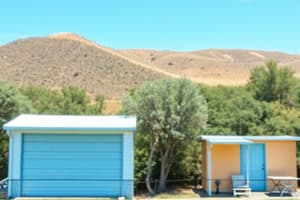Podcast
Questions and Answers
What are the two common ways of finding lines discussed in the lecture?
What are the two common ways of finding lines discussed in the lecture?
- Edge Grouping and Hough Transform (correct)
- Hough Transform and Sobel
- Edge Detection and Grouping
- RANSAC and Canny
Which method is mentioned as being available in any imaging package worthy of the name?
Which method is mentioned as being available in any imaging package worthy of the name?
- Hough Transform
- Canny (correct)
- Sobel
- RANSAC
What is described as a means to an end, rarely an end in itself in the context of computer vision?
What is described as a means to an end, rarely an end in itself in the context of computer vision?
- Sobel
- RANSAC
- Hough Transform
- Edge detection (correct)
What is the lecture mostly focused on using lines as a vehicle to discuss?
What is the lecture mostly focused on using lines as a vehicle to discuss?
Which technique involves creating contours from edge pixels and grouping them into higher level features?
Which technique involves creating contours from edge pixels and grouping them into higher level features?
What computational technique is mentioned in the lecture for managing outliers and achieving consensus?
What computational technique is mentioned in the lecture for managing outliers and achieving consensus?
What is a problem associated with the bottom-up approach of grouping edge pixels?
What is a problem associated with the bottom-up approach of grouping edge pixels?
What type of noise is a problem associated with the top-down approach of projection and matching?
What type of noise is a problem associated with the top-down approach of projection and matching?
In line fitting, what is the equation of a straight line typically represented by?
In line fitting, what is the equation of a straight line typically represented by?
What is one of the problems associated with finding parameters providing the best fit in line fitting?
What is one of the problems associated with finding parameters providing the best fit in line fitting?
How is the fit of the current solution measured in line fitting?
How is the fit of the current solution measured in line fitting?
What is the main idea behind least squares line fitting?
What is the main idea behind least squares line fitting?
What does the Hough transform provide an equation for?
What does the Hough transform provide an equation for?
What does the model in least squares regression aim to do?
What does the model in least squares regression aim to do?
In which space are lines typically plotted based on Cartesian coordinates?
In which space are lines typically plotted based on Cartesian coordinates?
Study Notes
Finding Lines
- Two common ways of finding lines: bottom-up and top-down approaches
- The Canny edge detector and the Hough transform are mentioned as methods for finding lines, with the Hough transform being available in any imaging package
Bottom-Up Approach
- Involves creating contours from edge pixels and grouping them into higher-level features
- Problem associated with this approach: noise and gaps in edge pixels
Top-Down Approach
- Involves projection and matching
- Problem associated with this approach: outlier noise
Line Fitting
- Equation of a straight line typically represented by: y = ax + b
- Problem associated with finding parameters providing the best fit: overfitting
- Fit of the current solution measured by: residual sum of squares
- Main idea behind least squares line fitting: minimize the residual sum of squares
Least Squares Regression
- Model aims to: find the best-fitting line that minimizes the residual sum of squares
- Provides an equation for: the best-fitting line
Hough Transform
- Provides an equation for: the parameters of the best-fitting line
Line Representation
- Lines are typically plotted in: Hough space based on Cartesian coordinates
Studying That Suits You
Use AI to generate personalized quizzes and flashcards to suit your learning preferences.
Description
Learn about edge detection and line finding in the context of computer vision. This lecture covers two common methods for finding lines: Edge Grouping, Hough Transform, and RANSAC. Topics include locating edges, differentiation of intensity function, and real-world applications.




